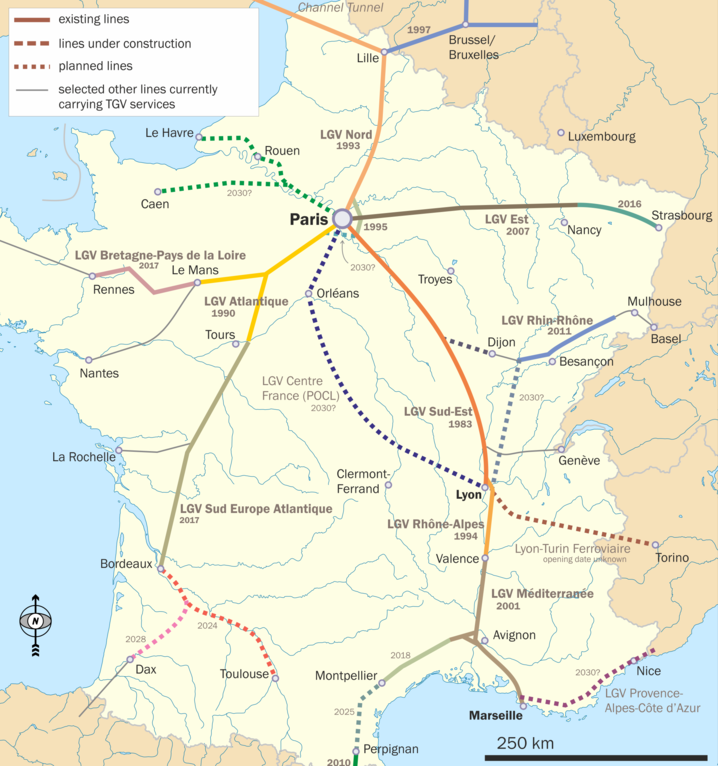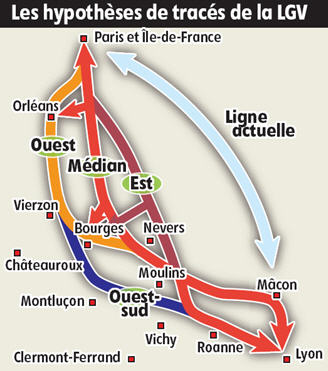beautifulplanet
Lead Service Attendant
- Joined
- Jan 29, 2014
- Messages
- 337
After being constructed on budget (inflation-adjusted), the first high-speed rail service (faster than 126mph/200kmh) outside of Japan started in France between Paris and Lyon just 33 years ago (well, 33 years and a month  ). See here:
). See here:
http://www.franceinfo.fr/emission/l-ephemeride/2014-2015/l-ephemeride-du-22-09-2014-22-09-2014-05-55
Public service started on September 22, 1981, with a speed of 162mph/260kmh, and was increased two years later with completion of both segments to 168mph/270kmh, eventually reaching 187mph/300mph. While the fastest prior service, the TEE Mistral took 3h 55mins from Paris to Lyon, TGV in 1983 took only 2h, essentially cutting the travel time in half. Thanks to the dedicated high-speed rail line, the TGV was considerably faster than cars, or airplanes. To counteract any misconception that the TGV would be a premium service for business travelers, a publicity campaign was started highlighting the speed, frequency, reservation policy, normal price, and broad accessibility of the service. Ridership expectations were exceeded. In 1984, the first full year of service with both segments of the high-speed line Paris-Lyon completed, more than 13 million people used the TGV service. Before 1981, 31% by of Paris-Lyon trips were done by air, 40% by train, and 29% by car. After 1984, this changed to approximately 7% travel by air, 72% travel by train, and 21% travel by car. The success of the high-speed rail line between Paris and Lyon was just the beginning of what was built out to be today's large TGV network, which will become even bigger in the future, with all the ongoing construction and further plans.
Here is a map of the French TGV network by Wikipedia user "classical geographer"
(not being 100% up to date, as planned lines Marseille-Nice, Montpellier-Perpignan and Bordeaux-Spain will be finished much later than 2020):

source:
http://upload.wikimedia.org/wikipedia/commons/thumb/0/07/France_TGV.png/718px-France_TGV.png
After its complete opening in 1983, the first line Paris-Lyon (LGV Sued-Est) was so successful, that it is nearly operating at capacity. Even using double-decker high-speed trains (a first for high-speed rail around the world), in order to increase the number of passengers transported with each train, was not enough to alleviate the very strong demand for high-speed rail. In 2014, the Paris-Lyon high-speed line is used for so many different services:
Not only Paris-Lyon itself, but also Paris-Marseille, Paris-Nice, Paris-Montpellier-Perpignan-Barcelona, Paris-Milano(Italy), Paris-Geneva(Switzerland), Paris-Basel (Switzerland), Marne-la-Vallee-Lyon, Marne-la-Vallee-Marseille, Brussels-Lyon, Lille-Marseille, London-Lille-Avignon, London-Lille-Bourg-Saint-Maurice among others. Next year in 2014, a new daily London-Lille-Marseille service by Eurostar will use the Paris-Lyon high-speed line as well. Also currently, TGV services coming from Mulhouse going south regularily use the existing classic line north of Lyon, possibly they could also change over to the high-speed line if there was more capacity.
In the part of the line seeing the highest usage, between Crisenoy and Passily, in 1999, the average daily use was roughly 220 trains a day, even about 250 trains on Fridays. As the line came into operation, a headway of 5 minutes was planned in terms of the signalling system. As the line came closer and closer to its capacity limits, between 1999 and 2001 the signalling system was modernized and the minimal technical headway decreased to just four minutes. In combination with increasing the top speed to 187mph/300kmh for most of the line, the practical capacity of the line was increased to 12 TGVs per hour and direction (leaving some slots unused as a buffer for delays).
More and more high-speed rail traffic is projected to come into service in the next years and decades, also between city pairs that would at least partially use the existing Paris-Lyon high speed line. That is why the French government is determined to proceed with building a completely new, second high-speed line (Lignes à grande vitesse in french, abbreviated LGV) between Paris-Lyon, roughly via Orleans and Clearmont-Ferrand, thus called LGV POCL. The work will be carried out by Réseau Ferré de France (RFF), the infrastructure company owning the french rail network and train stations.
As usual with huge infrastructure projects like new high-speed lines, a lot of planning and engineering is necessary, and all the respective stakeholders are informed and invited to give their input. There are several alternative routes that have been proposed, RFF indicated that it would like to choose the middle route. It is shorter than the western one when it comes to miles of route to be built, making it cheaper. And travel time between Paris and Lyon would be 10 minutes shorter compared to the existing line, which alone is estimated to lead to one million new travelers annually. In opposition to that, the western route would connect several cities more directly, which is why the respective majors oppose the middle route. Also, environmentalists and farmers oppose the middle route as it would cross the wine region of Sancerre.

source:
TGV Paris-Orléans-Clermont-Lyon : préférence pour le tracé médian [schéma]
July 15, 2014
by Franck Simon
http://www.lamontagne.fr/auvergne/actualite/2014/07/15/tgv-paris-orleans-clermont-lyon-preference-pour-le-trace-median-schema_11081167.html
Just the day before yesterday, the general council of the Département Nièvre announced that it will vote in support of the middle route, as will the inter-local body of the Nevers Agglomération. The reason obviously is that the middle route will nearly completely bypass the Nievre region, and completely bypass the Nevers region, while still passing by Nevers pretty closely, so possibly a new TGV train station could be build just outside of Nevers. The eastern route, in opposition to that, would pretty much cut through all of the Nievre region from north to south, so it's obvious there might not be so much local support in the region for that, here is a press report about the recent developments:
Nièvre : le tracé médian de la LGV est en discussion au Conseil Général
October 20, 2014
http://france3-regions.francetvinfo.fr/bourgogne/2014/10/20/nievre-le-trace-median-de-la-lgv-est-en-discussion-au-conseil-general-574808.html
Originally, a final decision on the route was expected by the end of 2014, meanwhile different sources suggest different dates during 2015. Many might be curious about when it will be made, and thus what then the estimate for start of construction and start of operations will be.
http://www.franceinfo.fr/emission/l-ephemeride/2014-2015/l-ephemeride-du-22-09-2014-22-09-2014-05-55
Public service started on September 22, 1981, with a speed of 162mph/260kmh, and was increased two years later with completion of both segments to 168mph/270kmh, eventually reaching 187mph/300mph. While the fastest prior service, the TEE Mistral took 3h 55mins from Paris to Lyon, TGV in 1983 took only 2h, essentially cutting the travel time in half. Thanks to the dedicated high-speed rail line, the TGV was considerably faster than cars, or airplanes. To counteract any misconception that the TGV would be a premium service for business travelers, a publicity campaign was started highlighting the speed, frequency, reservation policy, normal price, and broad accessibility of the service. Ridership expectations were exceeded. In 1984, the first full year of service with both segments of the high-speed line Paris-Lyon completed, more than 13 million people used the TGV service. Before 1981, 31% by of Paris-Lyon trips were done by air, 40% by train, and 29% by car. After 1984, this changed to approximately 7% travel by air, 72% travel by train, and 21% travel by car. The success of the high-speed rail line between Paris and Lyon was just the beginning of what was built out to be today's large TGV network, which will become even bigger in the future, with all the ongoing construction and further plans.
Here is a map of the French TGV network by Wikipedia user "classical geographer"
(not being 100% up to date, as planned lines Marseille-Nice, Montpellier-Perpignan and Bordeaux-Spain will be finished much later than 2020):

source:
http://upload.wikimedia.org/wikipedia/commons/thumb/0/07/France_TGV.png/718px-France_TGV.png
After its complete opening in 1983, the first line Paris-Lyon (LGV Sued-Est) was so successful, that it is nearly operating at capacity. Even using double-decker high-speed trains (a first for high-speed rail around the world), in order to increase the number of passengers transported with each train, was not enough to alleviate the very strong demand for high-speed rail. In 2014, the Paris-Lyon high-speed line is used for so many different services:
Not only Paris-Lyon itself, but also Paris-Marseille, Paris-Nice, Paris-Montpellier-Perpignan-Barcelona, Paris-Milano(Italy), Paris-Geneva(Switzerland), Paris-Basel (Switzerland), Marne-la-Vallee-Lyon, Marne-la-Vallee-Marseille, Brussels-Lyon, Lille-Marseille, London-Lille-Avignon, London-Lille-Bourg-Saint-Maurice among others. Next year in 2014, a new daily London-Lille-Marseille service by Eurostar will use the Paris-Lyon high-speed line as well. Also currently, TGV services coming from Mulhouse going south regularily use the existing classic line north of Lyon, possibly they could also change over to the high-speed line if there was more capacity.
In the part of the line seeing the highest usage, between Crisenoy and Passily, in 1999, the average daily use was roughly 220 trains a day, even about 250 trains on Fridays. As the line came into operation, a headway of 5 minutes was planned in terms of the signalling system. As the line came closer and closer to its capacity limits, between 1999 and 2001 the signalling system was modernized and the minimal technical headway decreased to just four minutes. In combination with increasing the top speed to 187mph/300kmh for most of the line, the practical capacity of the line was increased to 12 TGVs per hour and direction (leaving some slots unused as a buffer for delays).
More and more high-speed rail traffic is projected to come into service in the next years and decades, also between city pairs that would at least partially use the existing Paris-Lyon high speed line. That is why the French government is determined to proceed with building a completely new, second high-speed line (Lignes à grande vitesse in french, abbreviated LGV) between Paris-Lyon, roughly via Orleans and Clearmont-Ferrand, thus called LGV POCL. The work will be carried out by Réseau Ferré de France (RFF), the infrastructure company owning the french rail network and train stations.
As usual with huge infrastructure projects like new high-speed lines, a lot of planning and engineering is necessary, and all the respective stakeholders are informed and invited to give their input. There are several alternative routes that have been proposed, RFF indicated that it would like to choose the middle route. It is shorter than the western one when it comes to miles of route to be built, making it cheaper. And travel time between Paris and Lyon would be 10 minutes shorter compared to the existing line, which alone is estimated to lead to one million new travelers annually. In opposition to that, the western route would connect several cities more directly, which is why the respective majors oppose the middle route. Also, environmentalists and farmers oppose the middle route as it would cross the wine region of Sancerre.

source:
TGV Paris-Orléans-Clermont-Lyon : préférence pour le tracé médian [schéma]
July 15, 2014
by Franck Simon
http://www.lamontagne.fr/auvergne/actualite/2014/07/15/tgv-paris-orleans-clermont-lyon-preference-pour-le-trace-median-schema_11081167.html
Just the day before yesterday, the general council of the Département Nièvre announced that it will vote in support of the middle route, as will the inter-local body of the Nevers Agglomération. The reason obviously is that the middle route will nearly completely bypass the Nievre region, and completely bypass the Nevers region, while still passing by Nevers pretty closely, so possibly a new TGV train station could be build just outside of Nevers. The eastern route, in opposition to that, would pretty much cut through all of the Nievre region from north to south, so it's obvious there might not be so much local support in the region for that, here is a press report about the recent developments:
Nièvre : le tracé médian de la LGV est en discussion au Conseil Général
October 20, 2014
http://france3-regions.francetvinfo.fr/bourgogne/2014/10/20/nievre-le-trace-median-de-la-lgv-est-en-discussion-au-conseil-general-574808.html
Originally, a final decision on the route was expected by the end of 2014, meanwhile different sources suggest different dates during 2015. Many might be curious about when it will be made, and thus what then the estimate for start of construction and start of operations will be.





